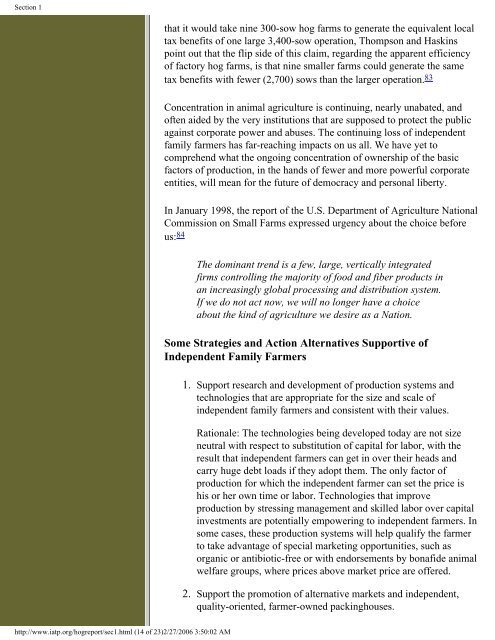IATP Hog Report - Institute for Agriculture and Trade Policy
IATP Hog Report - Institute for Agriculture and Trade Policy
IATP Hog Report - Institute for Agriculture and Trade Policy
You also want an ePaper? Increase the reach of your titles
YUMPU automatically turns print PDFs into web optimized ePapers that Google loves.
Section 1<br />
that it would take nine 300-sow hog farms to generate the equivalent local<br />
tax benefits of one large 3,400-sow operation, Thompson <strong>and</strong> Haskins<br />
point out that the flip side of this claim, regarding the apparent efficiency<br />
of factory hog farms, is that nine smaller farms could generate the same<br />
tax benefits with fewer (2,700) sows than the larger operation. 83<br />
Concentration in animal agriculture is continuing, nearly unabated, <strong>and</strong><br />
often aided by the very institutions that are supposed to protect the public<br />
against corporate power <strong>and</strong> abuses. The continuing loss of independent<br />
family farmers has far-reaching impacts on us all. We have yet to<br />
comprehend what the ongoing concentration of ownership of the basic<br />
factors of production, in the h<strong>and</strong>s of fewer <strong>and</strong> more powerful corporate<br />
entities, will mean <strong>for</strong> the future of democracy <strong>and</strong> personal liberty.<br />
In January 1998, the report of the U.S. Department of <strong>Agriculture</strong> National<br />
Commission on Small Farms expressed urgency about the choice be<strong>for</strong>e<br />
us: 84<br />
The dominant trend is a few, large, vertically integrated<br />
firms controlling the majority of food <strong>and</strong> fiber products in<br />
an increasingly global processing <strong>and</strong> distribution system.<br />
If we do not act now, we will no longer have a choice<br />
about the kind of agriculture we desire as a Nation.<br />
Some Strategies <strong>and</strong> Action Alternatives Supportive of<br />
Independent Family Farmers<br />
1. Support research <strong>and</strong> development of production systems <strong>and</strong><br />
technologies that are appropriate <strong>for</strong> the size <strong>and</strong> scale of<br />
independent family farmers <strong>and</strong> consistent with their values.<br />
Rationale: The technologies being developed today are not size<br />
neutral with respect to substitution of capital <strong>for</strong> labor, with the<br />
result that independent farmers can get in over their heads <strong>and</strong><br />
carry huge debt loads if they adopt them. The only factor of<br />
production <strong>for</strong> which the independent farmer can set the price is<br />
his or her own time or labor. Technologies that improve<br />
production by stressing management <strong>and</strong> skilled labor over capital<br />
investments are potentially empowering to independent farmers. In<br />
some cases, these production systems will help qualify the farmer<br />
to take advantage of special marketing opportunities, such as<br />
organic or antibiotic-free or with endorsements by bonafide animal<br />
welfare groups, where prices above market price are offered.<br />
2. Support the promotion of alternative markets <strong>and</strong> independent,<br />
quality-oriented, farmer-owned packinghouses.<br />
http://www.iatp.org/hogreport/sec1.html (14 of 23)2/27/2006 3:50:02 AM

















